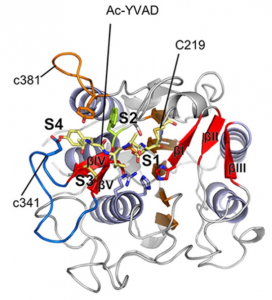LEXSY, an S1-compatible eukaryotic expression system based on the fast growing organism L. tarentolae has been used to express – among others – correctly folded, active plant proteins[1–4].
LEXSY carries out most eukaryotic post-translational protein modifications (PTMs) such as glycosylation, while retaining the ease of handling of prokaryotic systems. Plant proteins produced with LEXSY have also been successfully used for crystal structure determination (Fig. 1).

Figure 1: Crystal structure of the protease/peptide ligase legumain γ from Arabidopsis thaliana, expressed with LEXSY. From Zauner et al., 2018[1].
Need further information? Please check out the LEXSY section or contact us by email at expression@jenabioscience.com !
[1] Zauner at al. (2018) Crystal Structure of Plant Legumain Reveals a Unique Two-Chain State with pH-Dependent Activity Regulation. Plant Cell 30:686.
[2] Dadashipour at al. (2011) Comparative expression of wild-type and highly soluble mutant His103Leu of hydroxynitrile lyase from Manihot esculenta in prokaryotic and eukaryotic expression systems. Protein Expr. Purif. 77:92.
[3] Zauner at al. (2018) Structural analyses of Arabidopsis thaliana legumain γ reveal differential recognition and processing of proteolysis and ligation substrates. J. Biol. Chem. 293:8934.
[4] Dall at al. (2012) Activation of legumain involves proteolytic and conformational events, resulting in a context- and substrate-dependent activity profile. Acta Crystallogr. Sect. F Struct. Biol. Cryst. Commun. 68:24.